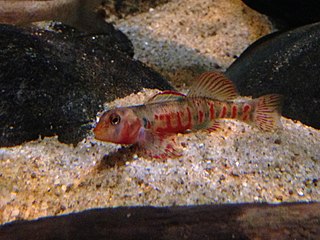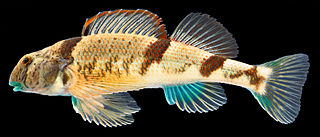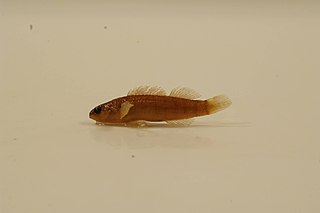
Etheostoma is a genus of small freshwater fish in the family Percidae, and within the sub-family Etheostomatinae, native to North America. Most are restricted to the United States, but species are also found in Canada and Mexico. They are commonly known as darters, although the term "darter" is shared by several other genera. Many can produce alarm pheromones that serve to warn nearby fish in case of an attack.

The Kanawha darter is a species of freshwater ray-finned fish, a darter from the subfamily Etheostomatinae, part of the family Percidae, which also contains the perches, ruffes and pikeperches. It is endemic to the southeastern United States.
The redband darter is a species of freshwater ray-finned fish, a darter from the subfamily Etheostomatinae, part of the family Percidae, which also contains the perches, ruffes and pikeperches. It is endemic to the state of Tennessee in the eastern United States.

The blenny darter is a species of freshwater ray-finned fish, a darter from the subfamily Etheostomatinae, part of the family Percidae, which also contains the perches, ruffes and pikeperches. It is a poorly known species which occurs in Alabama and Tennessee where it inhabits swift riffles.

The bluemask darter is a species of freshwater ray-finned fish, a darter from the subfamily Etheostomatinae, part of the family Percidae, which also contains the perches, ruffes and pikeperches. It is endemic to the eastern United States. It is a federally listed endangered species of the United States. This fish was not formally described until 2009, but it was added to the US Endangered Species List in 1993. During breeding, the male has bright blue patches on its head and other areas. This fish is found only in the Caney Fork River system, a tributary of the Cumberland River in Tennessee. The species name akatulo comes from the Cherokee for "mask", referring to the solid blue coloration on the lower face of the fish.
The Cumberland snubnose darter is a species of freshwater ray-finned fish, a darter from the subfamily Etheostomatinae, part of the family Percidae, which also contains the perches, ruffes and pikeperches. This species is found in the middle Cumberland River drainage in Tennessee, Kentucky, Virginia, North Carolina, Georgia, and Alabama. It is absent in reaches above the Big South Fork, rare in North Carolina, and absent in western tributaries of the Tennessee River. While research on the ecology of E. atripinne is not extensive, what is known is they are usually found in small to medium freshwater streams in gravel riffle areas where their eggs can attach to the substrate and be left unguarded. E. atripinne can be found within a wide range of depths in its environment, leading its being classified as benthopelagic. While its global status is secure, the American Fisheries Society labels it with a status of “Special Concern”.
The corrugated darter is a species of freshwater ray-finned fish, a darter from the subfamily Etheostomatinae, part of the family Percidae, which also contains the perches, ruffes and pikeperches. It is endemic to the eastern United States only known from Caney Fork, Tennessee, where it has been shown to have as many as five subgroups. They are active hunters which prey on insects, fry, and possibly young snails. Multiple species and subspecies of these darters can coexist where substrate is varied, so this must be carefully preserved to accommodate many similar species. With the warming of spring, E. basilare enters its breeding cycle and males develop their dimorphic coloration. Like most darters, it hugs the stream bed, using its body shape and fin posture to maintain its position.

The buffalo darter is a species of freshwater ray-finned fish, a darter from the subfamily Etheostomatinae, part of the family Percidae, which also contains the perches, ruffes and pikeperches. It is found in the tributaries of the lower Duck and lower Tennessee Rivers. It is distinguished from other darter species by the presence of eight anal rays, as well breeding males having a unique hump behind the head reminiscent of a buffalo.
The stone darter is a species of freshwater ray-finned fish, a darter from the subfamily Etheostomatinae, part of the family Percidae, which also contains the perches, ruffes and pikeperches. It is endemic to the eastern United States.
The cherry darter is a species of freshwater ray-finned fish, a darter from the subfamily Etheostomatinae, part of the family Percidae, which also contains the perches, ruffes and pikeperches. It is endemic to the upper Caney Fork system of the Cumberland River drainage in the U.S. state of Tennessee.
The brighteye darter is a species of freshwater ray-finned fish, a darter from the subfamily Etheostomatinae, part of the family Percidae, which also contains the perches, ruffes and pikeperches. It is endemic to the eastern United States. The brighteye darter was first described by Oliver Perry Hay in 1885. He noted it is closely related to the banded darter. Until the 1970s, the brighteye darter was generally believed to be a genetic variation of the banded darter.

The snubnose darter is a species of freshwater ray-finned fish, a darter from the subfamily Etheostomatinae, part of the family Percidae, which also contains the perches, ruffes and pikeperches. It is endemic to the southeastern United States.

The gulf darter is a species of freshwater ray-finned fish, a darter from the subfamily Etheostomatinae, part of the family Percidae, which also contains the perches, ruffes and pikeperches. It is found in Louisiana, Mississippi, Alabama, Florida, Tennessee, and Kentucky. It is a colorful fish, males having vertical barring of red-orange and blue-green near the tail, growing to a length of about 7.8 centimeters (3.1 in). It is typically found in small and medium-sized creeks, often in very shallow water. It occurs over sandy bottoms and among aquatic vegetation such as Sparganium americanum, foraging among the plants and organic debris for insect larvae and small invertebrates. The International Union for Conservation of Nature has assessed its conservation status as being of "least concern".

The Swannanoa darter is a species of freshwater ray-finned fish, a darter from the subfamily Etheostomatinae, part of the family Percidae, which also contains the perches, ruffes and pikeperches. It is endemic to the eastern United States where it occurs in the drainage of the Tennessee River. It prefers flowing water in riffles in cool, clear mountain streams, with boulder substrates. The diet and natural history of this species have been little studied but are probably similar to those of its close relative, the greenside darter. The population trend of this fish seems to be stable and it is a common species with numerous sub-populations over its limited range, and the International Union for Conservation of Nature has assessed its conservation status as being of "least concern".

The Tippecanoe darter is a species of freshwater ray-finned fish, a darter from the subfamily Etheostomatinae, part of the family Percidae, which also contains the perches, ruffes and pikeperches. It is endemic to the eastern United States.
The seagreen darter is a species of freshwater ray-finned fish, a darter from the subfamily Etheostomatinae, part of the family Percidae, which also contains the perches, ruffes and pikeperches. It is found in the Santee River drainage of North and South Carolina. It inhabits rocky riffles of creeks and small to medium rivers. This species can reach a length of 8.0 cm (3.1 in), though most only reach about 6.0 cm (2.4 in).
The turquoise darter is a species of ray-finned fish, a darter from the subfamily Etheostomatinae, part of the family Percidae which includes the perches, ruffes and pike-perches. It is found in the Edisto, Savannah and Altamaha River drainages of North Carolina, South Carolina and Georgia in the United States. It inhabits rocky riffles of creeks and small to medium rivers. This species can reach a length of 8.0 cm (3.1 in), though most only reach about 6.0 cm (2.4 in).

The Tuckasegee darter is a species of ray-finned fish, a darter from the subfamily Etheostomatinae, part of the family Percidae which includes the perches, ruffes and pike-perches. It is endemic to the eastern United States, where it occurs in the headwaters of the Little Tennessee River and some tributaries to the Pigeon River in eastern Tennessee, western North Carolina and extreme northeastern Georgia. It inhabits fast rocky riffles of creeks and small rivers.
The Sequatchie darter is a species of freshwater ray-finned fish, a darter from the subfamily Etheostomatinae, part of the family Percidae, which also contains the perches, ruffes and pikeperches. It is endemic to the eastern United States, where it occurs only in the Sequatchie River in Tennessee. It is considered by some authorities to be a subspecies of the blenny darter.
The Tennessee darter is a species of freshwater ray-finned fish, a darter from the subfamily Etheostomatinae, part of the family Percidae, which also contains the perches, ruffes and pikeperches. It is endemic to the eastern United States, where it occurs in the Tennessee River drainage from western Virginia to western Tennessee. It also occurs in the upper Bluestone River drainage in western Virginia. It inhabits current-swept rocky pools and adjacent riffles of creeks and small to medium rivers. This species can reach a length of 6 cm (2.4 in).












